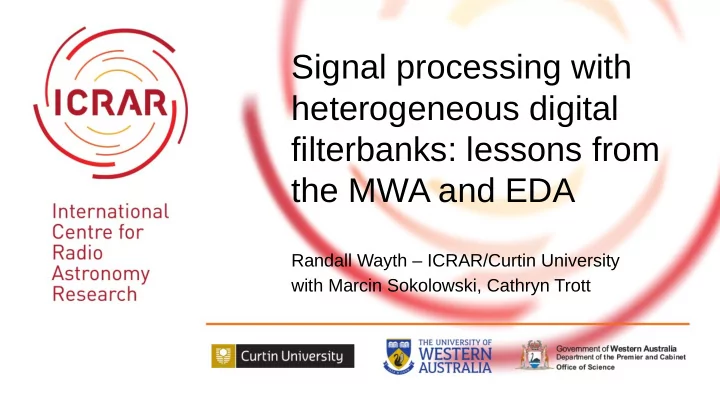

Signal processing with heterogeneous digital filterbanks: lessons from the MWA and EDA Randall Wayth – ICRAR/Curtin University with Marcin Sokolowski, Cathryn Trott
"Holy grail of CASPER system is multi-user system” Outline Jack H on Monday Goal: Ingest digital data from EDA into MWA correlator to measure the SEFD of EDA Heterogeneous Filterbanks 2 2
Heterogeneous Filterbanks 3
MRO (operated by CSIRO) On site: data rate into central building ~60 Gbps 41,000 sq. km = The Netherlands Geraldt Ofg site: data rate into science archive ~3 Gbps on Perth Pawsey Centre 20 PB storage ~200 km 4 for MWA
Antenna tiles: 4x4 array of dual pol dipoles Beamformer
Receivers: Receivers: • Each receiver services 8 tiles • Each receiver services 8 tiles • Sky signal is digitised and sent to central • Sky signal is digitised and sent to central processing processing facility facility
Central Signal Processing: • 128 dual pol tiles • 30.72 MHz bandwidth, 10 kHz spectral resolution • 8128 baselines • Visibilities integrated to ~1s time resolution
MWA digital signal path Tremblay et al, 2015 Software correlator 10 kHz fjne channels 12(?) tap PFB 10G ethernet 24 x 1.28 MHz coarse channels. 8-tap PFB 8 8
Engineering Development Array (EDA) Signatec PX-1500 GTX 750 Heterogeneous Filterbanks 9
MWA correlator inputs MWA: EDA: • Sample rate 655.36 Msamp/sec • Sample rate 655.36 Msamp/sec • 8-tap critically sampled PFB for – Uses MWA clock • Do 65536-sample FFT to directly coarse channels (1.28 MHz) • 12-tap critically sampled PFB for transform to 10 kHz channels (easy on GPU) fine channels (10 kHz) Result: • Brute-force fringe search using Sun as source • Clear lag, but at equal magnitude for 5 and 6 samples • SNR of cross-correlation at either lag is lower than expected, but roughly equal • WTF? Heterogeneous Filterbanks 10 10
Analysis Consider weighted-overlap-add model of a PFB • Each chunk of signal appears in the window n_taps times • For even-sized PFB, signal appears twice with equal power (but mirror reflected weights) with largest weights For FFT-based spectrometer, signal from any block of input samples only appears in output once . From Crochiere & Rabiner, 1983 “Multirate digital signal processing” Heterogeneous Filterbanks 11
Analysis • Coarse chan data The correlator works on the fjne channels out of the DFT • Fine channels will correlate ifg the same (broadband) signal went into the fjlterbank at time t . FFT only • Obvious from inspection that signal contributing to time t in PFB also contributes to time t+1 . • If we lag correlate fjne channel time series from FFT and PFB we would expect equal amplitude for times t and t+1 . • BUT, for a given lag, more than 50% of DFT output will not correlate. -> Low SNR Fine chan data Heterogeneous Filterbanks 12 12
Analysis + + DFT DFT DFT DFT Heterogeneous Filterbanks 13 13
Analysis + + DFT DFT DFT DFT Heterogeneous Filterbanks 14 14
Analysis + + DFT DFT DFT DFT Heterogeneous Filterbanks 15 15
Analysis + + DFT DFT DFT DFT Heterogeneous Filterbanks 16 16
Analysis + + DFT DFT DFT DFT Heterogeneous Filterbanks 17 17
Analysis + + DFT DFT DFT DFT Heterogeneous Filterbanks 18 18
Simulation summary Fine chan data streams Noise data streams FFT direct FFT direct d1 to fjne d1 “EDA” to fjne chans chans Even PFB Even PFB 10% common signal power to fjne “MWA” to fjne chans chans PFB PFB Odd PFB Odd PFB to coarse to coarse d2 d2 to fjne to fjne chans. chans. chans Select 1 chans Select 1 FFT FFT to fjne to fjne chans chans Heterogeneous Filterbanks 19 19
Simulation – even sized PFB Generate noise time series • Channelise to coarse channels using PFB • Fine channelise using – Even-sized PFB and – FFT • Find lag in fine channel time series • Equal lag magnitude and t=0 and t=1 Heterogeneous Filterbanks 20
Simulation – odd sized PFB Generate noise time series • Channelise to coarse channels using PFB • Fine channelise using – Odd-sized PFB and – FFT • Find lag in fine channel time series • Significant lag only at t=0 Inspecting time series of fine channels, the effect is obvious. Heterogeneous Filterbanks 21
22
By eye comparison of odd vs even vs fft Heterogeneous Filterbanks 23
Simulation - SNR Stddev in phase = proxy Simulate MWA/EDA system: for SNR • PFB for coarse chans, then fine channelisation • FFT x FFT (ideal case) 0.033 • FFT x (…options) 0.033 0.054 0.084 Results: • method of coarse channelisation not important • Odd-sized PFB better SNR than even sized PFB when correlated with FFT fine channels Heterogeneous Filterbanks 24
Proof of the pudding… EDA into MWA EDA sensitivity (via SEFD) as measured by noise in calibrated visibilities • All data correlated in MWA correlator • Calibration via normal MWA calibration on strong compact source • Using 4-tap PFB in EDA improves SNR by 2x vs straight FFT Heterogeneous Filterbanks 25 25
Summary – heterogeneous filterbanks • Odd and even-sized filterbanks do not play nice when correlated • There is no fundamental reason why an even or power-of-two number of taps is required in a PFB Odd-sized number of taps gives • closer representation to intuitive FFT result • SNR of correlated data is affected by match (or mismatch) in PFB window used Heterogeneous Filterbanks 26
Jobs@ICRAR International Centre for Radio Astronomy Research Perth, Western Australia Partners in MWA • ICRAR • CAASTRO • ASTRO-3D • SKA-Low •
Recommend
More recommend